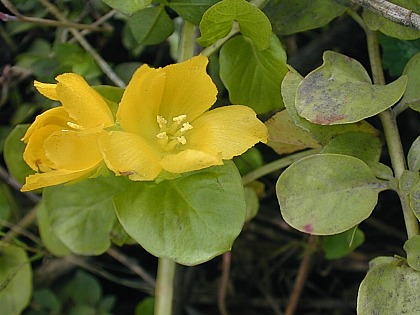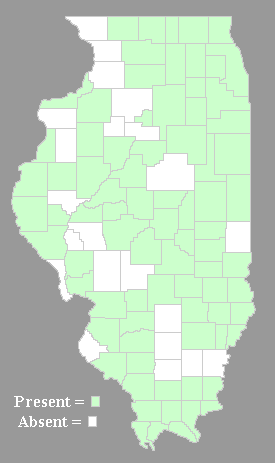Description: This perennial plant is a non-climbing herbaceous vine up to 3' long that freely branches at the base. The light green stems are hairless and somewhat angular or ridged. The opposite leaves are about 1–1½" across and amply separated from other pairs of leaves on the stems. They are orbicular, orbicular-cordate, or orbicular-oval in shape, smooth along the margins, and hairless. The upper surface of the leaves is often shiny and has widely scattered glandular black dots. The leaves have short hairless petioles about ¼" in length.

From the axil of
each leaf, there occasionally appears a single yellow flower on a short
pedicel. Each flower is about 1" across, consisting of 5 yellow petals
(actually petal-like lobes of the corolla), 5 yellow stamens, a single
green pistil, and a green calyx with 5 triangular or broadly lanceolate
teeth. This calyx is hairless and its teeth are shorter than the
petals. The petals have scattered glandular dots that are dark red. On
rare occasions, some plants will produce flowers with 6 petals and 6
stamens. The blooming period occurs intermittently from late spring to
late summer, and can last 2-3 months for a colony of plants, although
usually few flowers are produced, which bloom during daylight hours.
Rarely are seed capsules produced by these flowers. When it occurs, a
seed capsule is ovoid in shape and has 5 cells, each cell containing
several closely packed seeds. Moneywort often forms new roots at the
axils of the opposite leaves, generating new stems that have a tendency
to spread across the ground in all directions. These roots are rather
slender and fibrous. Moneywort often forms clonal colonies.
 Cultivation:
The preference is full sun to light shade, moist conditions, and a
fertile loamy soil that is not too acidic. This plant will also grow in
shallow water, wet mucky soil, and more mesic conditions. This plant
can spread aggressively.
Cultivation:
The preference is full sun to light shade, moist conditions, and a
fertile loamy soil that is not too acidic. This plant will also grow in
shallow water, wet mucky soil, and more mesic conditions. This plant
can spread aggressively.
Range & Habitat:
Moneywort is a common plant that is found in most counties of Illinois.
It was introduced into the United States as an ornamental plant from
Europe, where it is native. Habitats include seeps, fens, ditches,
woodland borders, thickets, moist areas of black soil prairies,
cemeteries, and edges of yards. Sometimes this plant is grown in flower
gardens – some of the cultivars have yellowish foliage, otherwise they
are quite similar to the wild plant. Moneywort can occur in either
natural or disturbed areas – it is often invasive and difficult to get
rid of. In cemetery prairies where this plant occasionally occurs, it
functions as an understory plant and can tolerate the shade of the
taller grasses and forbs.
Faunal Associations:
The flowers attract bees occasionally, which collect pollen from the
anthers. The flowers of Moneywort probably provide a floral oil like
other Lysimachia spp., which is collected by the
oligolectic Macropsis steironematis and other
Melittid bees for their bee-grubs. In many areas, Melittid bees are
rather uncommon, which may be the reason Moneywort often fails to form
seed capsules. Some horticultural nurseries report that Moneywort
attracts birds and butterflies, but this is untrue because the flowers
provide no nectar for the butterflies and rarely form seeds for the
birds. The bitter-tasting foliage of Moneywort is not a preferred food
source for mammalian herbivores, although rabbits and groundhogs may
eat it occasionally. The bitterness is the result of such substances as
saponins, tannin, and salicic acid.
Photographic Location:
An area prone to flooding in a restored prairie at Meadowbrook Park in
Urbana, Illinois.
Comments:
The large yellow flowers and shiny foliage are reasonably attractive,
although the stems of this plant have a tendency to sprawl chaotically.
Among the various plants that are vines, Moneywort is easy to identify
because of the pairs of cute round leaves and relatively large flowers
that resemble the flowers of many Oenothera spp.
(Evening Primroses). None of the other Lysimachia spp.
(Loosestrifes) that occur in the wild in Illinois have a vine-like
habit and such round leaves. Unlike the Evening Primroses, the stigma
of Moneywort is a tiny knob, rather than cross-shaped. Another common
name for this plant is Creeping Jenny.